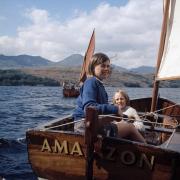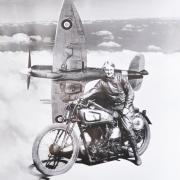With more than 125 hours of flight training needed before becoming a captain, piloting Europe’s only year-round hovercraft passenger service is no walk in the park.

Steve Atrill has an unusual job in passenger transport. As a hovercraft operator, he uses controls that point to him flying a plane, among them engine throttles, propeller pitch controls and air rudders. Indeed, his working hours are recorded in a flying logbook. Meanwhile, the marine radar, electronic sea charts and all-important windscreen wipers underline that he is skipping over the waves rather than flying high.
Steve is fleet captain – or maybe that should be head pilot – for Hovertravel, which provides a passenger service between Southsea and Ryde on the Isle of Wight. Hovertravel is the world’s oldest hovercraft operator, first starting in 1965, and the crossing of the Solent is now the only year-round passenger hovercraft service in Europe. That is quite something to have on your CV.
Aged in his mid-50s and living on the Isle of Wight, Steve has been a hovercraft pilot since 1988. It seems he was almost destined for his role. “I had an interest in the hovercraft industry from a young age and as an islander had witnessed the development of successive hovercraft types built on the Isle of Wight,” he says. “I served at sea in the Merchant Navy with long periods spent away from home but wanted to have more quality time with my family and friends. I have also flown many types of aircraft, including working for the military and the police, and the chance to join Hovertravel and integrate my seafaring and flying experience was a great opportunity!”
It is true that the Isle of Wight and the Solent in general can be considered the ancestral home of the hovercraft. Its inventor, Sir Christopher Cockerell, lived at East Cowes and then for many years at Hythe, Southampton. Obsessed with trying to make boats go faster, the engineer once famously conducted a kitchen table experiment with two tin cans and a vacuum cleaner. He showed that if you could create a cushion of air under an object, it would greatly reduce drag when it started moving. While there remains some uncertainty over whether the experiment involved two coffee tins or a coffee tin and a cat food tin, it is clear today that Cockerell was a prime example of a great British inventor. Nevertheless, he struggled to get his idea taken seriously at the time. Eventually, with government assistance, a prototype hovercraft was built by Saunders-Roe, a flying boat company based at Cowes, under the guidance of Cockerell. In July 1959 – on the 50th anniversary of Louis Blériot’s first powered flight over the Channel – it made an audacious crossing from Calais to Dover with its creator on board. And in the summer of 1965 hovercraft started ferrying passengers between Southsea, Gosport and the Isle of Wight.

Early hovercraft were somewhat noisy monsters and could be heard leaving Southsea Beach from Portsdown Hill, five miles away. Steve gets to pilot the rather more refined descendants Solent Flyer and Island Flyer – two 12000TD craft built by Griffon Hoverwork on the River Itchen in Southampton.
The journey across the Solent takes just ten minutes. It begins with Steve starting up the engines and performing pre-departure checks. On board with him are two other crew, one assisting in the cockpit and another in the passenger cabin.
“The hovercraft has two engines, each driving a pair of lift fans and a propeller on its respective side of the craft,” explains Steve. “I control the throttles to adjust engine rpm. Increasing the setting causes the lift fans to work harder, deepening the air cushion held in place by the skirt and increasing the lift, while at the same time spinning the propellers faster giving more thrust. Movement is further controlled by varying the angle of the propeller blades to deliver forward or astern power as required. I then steer the hovercraft with two sets of rudders lying in the airstream behind the propellers.”
It may all sound straightforward but controlling a hovercraft is far more complicated than a ‘normal’ ship or boat. “As the hovercraft has minimal contact with the water or land surface, you need specialist training to become a pilot,” says Steve. Hovertravel operates an approved training school to train its pilots and they typically take three months to achieve a minimum of 125 hours of piloting experience before becoming qualified as a captain. As one of Hovertravel’s most experienced pilots, Steve oversees the training and compliance of both pilots and crew.

A further complicating factor for the pilot is the weather, with the speed and aspect of the craft making it sensitive to choppy waters. “I have to set the engine power to suit the conditions,” says Steve. “I also adjust the pitch and roll attitude of the craft using the water ballast system. This pumps 1,500 litres of water between four tanks on board to maintain the optimum speed and stability.”
If the conditions are too rough, then the hovercraft will not go out. Hovercraft are governed by the Maritime and Coastguard Agency which prohibits operations when the waves or swell are 1.5 metres high.
Against that, a hovercraft is not affected by the tides in the way that a boat would be and the lack of direct contact with the water gives the hovercraft the ability to move in any direction, easily sliding sideways or backwards with little resistance. Think of it as the queen on a chess board.
Once Steve’s hovercraft is underway, his main job is to ensure a safe passage. “The Solent is one of the busiest shipping areas in the UK with numerous commercial vessels and recreational craft sharing the same space,” says Steve. “I have to maintain a sharp lookout, assisted by charts and radar.” In the hours of darkness or in reduced visibility, there will also be a navigator in the cockpit to assist him.

The journey is also spent monitoring the craft technical systems and ensuring the welfare of the passengers and crew. The passengers are almost certainly looking out the windows. There is a fascinating panorama to witness through the large picture windows, albeit flashing by at a fairly rapid pace. Apart from Southsea Castle, the Solent Forts and the half-mile long Ryde Pier – the world’s oldest seaside pleasure pier – there are also likely to be other ships and craft to look out for, including Wightlink catamarans and car ferries, cross-channel ferries, ocean cruise ships, merchant shipping and perhaps even a passing Royal Navy destroyer or frigate.
But the journey comes to an end all too quickly. “As I approach the destination, I configure the craft for landing, aligning it with final approach track and making the transition from sea to land at a speed selected for the weather conditions and state of tide,” says Steve. “In this way, I aim to deliver a smooth touchdown!”
Everything is not all down to Steve, of course. There are many other staff, including crew, engineers and customer service people, keeping him ‘afloat’. They all have important parts to play, albeit perhaps not so glamorous as Steve’s. “A hovercraft pilot is a unique role and the opportunity to be one of only a few pilots in the world makes the job quite special!” he admits.
Steve is clearly happy to spend his days shooting backwards and forwards between Southsea and Ryde like a shuttle on a loom. It can be only an exhilarating experience, not unlike walking on air, which kind of makes sense really.
Good to know
Solent Flyer and Island Flyer are 12000TD craft built by Griffon Hoverwork of Southampton
Power: Two 1,100HP diesel engines
Capacity: 80 passengers, a total of 800,000 passengers are carried by Hovertravel each year
Crew: Three or four
Listed top speed: 45 knots at full payload
Journey time between Southsea and Ryde: Ten minutes
discover more
During the coronavirus lockdown the hovercraft service is still operating but for essential journeys only such as key workers and vital supplies. Please check with Hovertravel for details of current travel restrictions at hovertravel.co.uk
For more on the history of the hovercraft and its Hampshire origins visit The Hovercraft Museum in Marine Parade West, Lee-on-the-Solent. The volunteer-run working museum has among its exhibits the restored the SRN4 The Princess Anne, which was the largest commercial hovercraft ever built, the military BH7, hovercrafts used in James Bond’s Die Another Day, plus two hovercrafts made for the series Scrapheap Challenge. It is currently closed because of the coronavirus lockdown. For more information visit hovercraft-museum.org
If you fancy buying your own hovercraft to impress the neighbours, visit griffonhoverwork.com



























